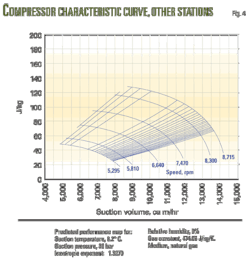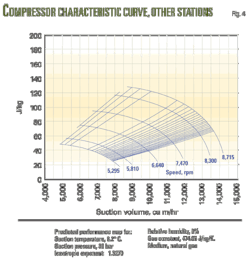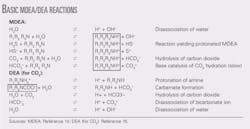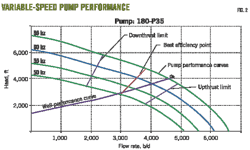The presence of negative thermal anomalies over petroliferous basins has been reported from field data1 2 and from satellite remote sensing data.3 In this article we present physical aspects of the problem from a theoretical point of view.
The theoretical modeling carried out here shows the expected presence of negative surface thermal anomalies over oil pools, and the approach can be used in the early stages of exploring a sedimentary basin for oil and gas by identifying thermal anomalies after filtering thermal effects for other elements such as topography, water, vegetation, and artifacts.
Consider the simplified case of heat flow in a homogeneous isotropic medium for which Fig. 1 represents a vertical cross section. Assuming that the heat transfer mechanism is by conduction alone, heat is generated by radioactive decay, and assuming that the source at the basement of the basin is continuous in time, the temperature field within the model can be described by two-dimensional steady-state heat conduction equations 1 and 2 (see equation box).
Subject to boundary conditions given by expressions (i), (ii), and (iii), where, T(X, Z) is the variable temperature; T0 is the surface temperature; K(X,Z) is thermal conductivity; Qg(X,Z) is radiogenic heat production; q is heat production near surface; b is logarithmic decrement;4 L and H are the length and depth of the model under consideration, respectively; QH is the heat flow at the base of the model; QS is the heat flow at surface; and X and Z are the orthogonal coordinates in horizontal and vertical directions, respectively.
In order to solve this boundary value problem for the calculation of temperature distribution, one should know the values of all the controlling parameters such as K(X, Z), Qg(X, Z), L and H, etc., that appear in equations 1 and 2.
Applying boundary condition (ii), equation 2 reduces to equation 3.
Particularly integral of equation 3 is equation 3a.
Complementary function of equation 3 is equation 3b.
Using equations 3a and 3b, the solution becomes equation 4.
Using boundary conditions (i) and (iii) in equation 4, the solution is expressed in equations 5 and 6.
From equation 6 we can conclude that within a basin the temperature-depth relationship mainly depends on the thermal conductivity of the formation. With the known values of various parameters we can compute the temperature-depth relationship at different depths of the basin.
Temperature-depth profiles
In the present work we have taken the onshore Cambay basin in India, a well known petroliferous Tertiary basin having a large number of oil fields, as a test site to validate the above computation.
Kalol oil field is well exploited and well studied. For this study, the values of various parameters can be taken as follows from the Kalol area:
a) Qg(X,Z) up to 7 km depth is obtained assuming appropriate models having crustal layer with uniform radioactivity5 and decreasing crustal radioactivity with depth in the basin according to Qg(X,Z) = qeZ/b(4)
b) q = 1.6 μW/m3, b =11, K(X, Z) = 2.5 W/mK up to Z =116
c) Qs = 75 mW/m27
d) For T0, a number of curves have been drawn to correspond to various possible initial ground temperatures (T0) of 300, 302, 304, 306, 308, and 310 K.
According to Fourier's law of conduction, heat flow in the earth is uniform. Assuming the thermal conductivity of strata to be constant, the temperature gradient would be constant and it would plot as a straight line (Fig. 2).
In the field, the temperature-depth profiles have been measured in two wells located in the northern part of Kalol field and are shown using data from Oil & Natural Gas Commission in Fig. 2. An important point to note is that the temperature-depth profiles exhibit a change in thermal gradient in the form of an inflexion point at 1,900-2,000 m, the depth above which a number of hydrocarbon pools are known to occur in the area.
The field measured temperature-depth profiles can be compared with the regional (background) nominal temperature-depth profile.
It is observed that the modeled rectilinear temperature-depth profile corresponding to 306 K intersects the measured temperature-depth profiles at the inflexion point (the depth above which a number of hydrocarbon pools are known to occur); therefore it is taken as the nominal profile to represent the reference for the area.
A synthetic isothermal plot (Fig. 3) explains a subsurface temperature distribution in the hydrocarbon-filled formation where negative thermal anomaly above and positive thermal anomaly below the hydrocarbon bearing zone is indicated. Thus, a negative thermal anomaly could be expected to be associated with hydrocarbon occurrence in the region, and may be about 5-7 K at the ground surface.
However, the distribution of surface temperatures on the earth's surface is greatly affected by external solar heating, meteorological factors, and thermal behavior of the earth's surface features (topography, land use/land cover such as water, vegetation, etc.) (Fig. 4).
On the ground surface the net thermal effect of solar heating and earth's surface features/processes may be quite significant and possesses high spatial frequency. This would tend to mask the temperature variation arising due to the internal crustal heating process (Fig. 4).
Thus the thermal anomaly over petroliferous basins can possibly be detected provided the various other thermal effects (due to external and earth's surface processes) could be excluded/minimized by careful data processing, as has been earlier presented in these columns.3
Acknowledgment
Thanks to Oil and Natural Gas Commission, Dehradun, for kindly providing support in this study.
References
1. Fons, L., "Temperature method can help locate oil, gas deposits," OGJ, Apr. 5, 1999, p. 58.
2. Fons, L., "Temperature anomaly mapping identifies subsurface hydrocarbons," World Oil, September 2000.
3. Gupta, R.P., Chakraborty, R., and Awasthi, A.K., "Satellite data can cost effectively show oil field thermal anomalies," OGJ, Nov. 2, 2009, pp. 34-36.
4. Lachenbruch, A.H., "Geothermal method for Sierra Nevada," Journal of Geophysical Research, Vol. 73, 1968, pp. 6,977-89.
5. Ray, L., Bhattacharya, A., and Roy, S., "Thermal conductivity of Higher Himalaya Crystallines from Garhwal Himalaya, India," Tectonophysics, Vol. 434, 2007, pp. 71-79.
6. Gupta, L.M., "Surface heat flow and igneous intrusions in the Cambay basin, India," Journal of Volcanology and Geothermal Research, Vol. 10, 1981, pp. 272-292.
7. Panda, P.K., "Geothermal maps of India and their significance in resource assessments," Petroleum Asia Journal, Vol. 8, No. 2, 1985, pp. 202-210.
The authors
More Oil & Gas Journal Current Issue Articles
More Oil & Gas Journal Archives Issue Articles
View Oil and Gas Articles on PennEnergy.com









